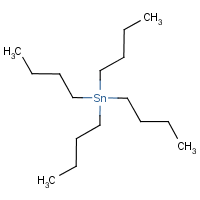Tetra-n-butyltin
Agent Name
Tetra-n-butyltin
CAS Number
1461-25-2
Formula
C16-H36-Sn
Major Category
Metals

Synonyms
Stannane, tetrabutyl-; Tetra-n-butylcin [Czech]; Tetrabutylstannane; Tetrabutyltin; Tin, tetrabutyl-; [ChemIDplus] UN2788
Category
Tin Compounds, Organic
Description
Colorless or slightly yellow liquid; [Hawley] Colorless liquid; [MSDSonline]
Sources/Uses
Used as a silicone additive, lubricant, fuel additive, polymerization catalyst, and hydrochloric acid scavenger; [Hawley]
Comments
In lethal dose animal studies, causes somnolence (general depressed behavior); Oral LD50 (rat) = 1268 mg/kg; Intravenous LD50 (rat) = 48 mg/kg; [ChemIDplus] An irritant; [Hawley] An irritant; May cause skin and respiratory sensitization after prolonged contact; [MSDSonline] See "ORGANOMETALS." See "Tin, organic compounds."
Biomedical References
Exposure Assessment
Skin Designation (ACGIH)
Yes
TLV (ACGIH)
0.1 mg/m3, as Sn
STEL (ACGIH)
0.2 mg/m3, as Sn
PEL (OSHA)
0.1 mg/m3, as Sn
MAK
0.02 mg/m3, inhalable fraction
IDLH (NIOSH)
25 mg/m3, as Sn
Vapor Pressure
0.0048 mm Hg
Lethal Concentration
LC50 (mice) = 142 mg/m3
Explanatory Notes
The Guide in the Emergency Response Guidebook is for "Organotin compound, liquid, n.o.s." Organic tin compounds have a "skin" designation and are classified as "A4" (Not classifiable as human carcinogen); [ACGIH]
Adverse Effects
Neurotoxin
Other CNS neurotoxin
Hepatotoxin
Hepatoxic (a) from occupational exposure (secondary effect) or (b) in animal studies or in humans after ingestion
ACGIH Carcinogen
Not Classifiable
Diseases, Processes, and Activities Linked to This Agent
Processes
Industrial Processes with risk of exposure: